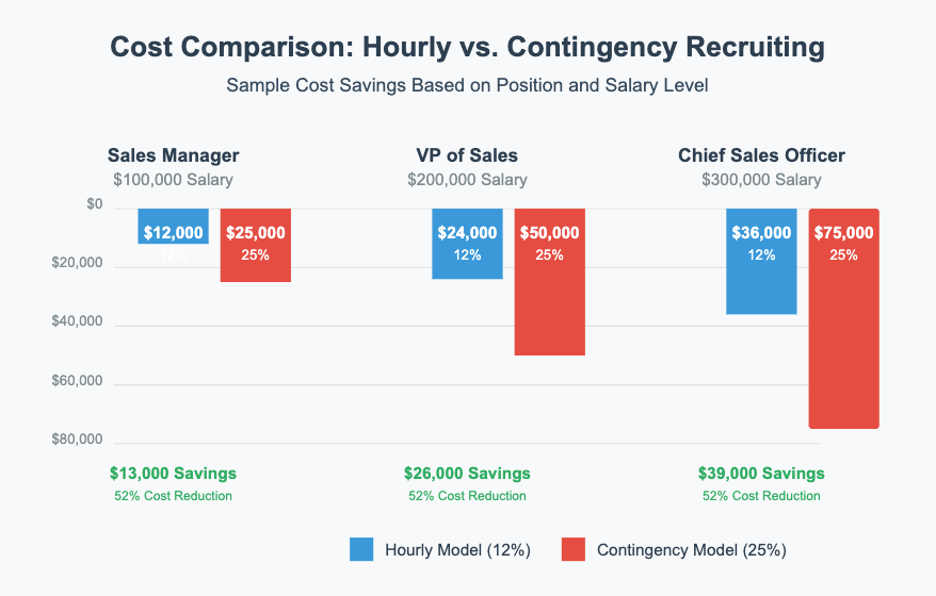
Which Recruiting Model Helps You Find the Best Talent?
What is your company’s competitive edge? If you did not answer “having the most talented team,” you are missing out on a huge opportunity to set your company apart from the competition.
The people you hire today will define your company’s future. Every hiring decision impacts business performance, shapes company culture, and directly influences employee engagement and retention.
Bad hires and vacant positions can cost your company a lot, not just in hard costs but also by draining productivity and team morale. Your recruiting approach isn’t just an operational choice—it’s a strategic imperative with long-term financial consequences.
If your recruiting and hiring needs are outstripping your internal resources, time or expertise, considering a third-party recruiter is essential. But which one? You likely get 40 emails a day from recruiters claiming to be the best. Let’s break down the landscape and help you find the recruiting solution that will improve both your hiring outcomes and your bottom line.
Understanding Recruiting Models
There are many models with different ways of billing but three you are likely to see are:
- Hourly or Time-Based Recruiting® (pay by the hour for work done, like you would an accountant or graphic designer).
- Contingency (commission-based common in sales and real estate)
- Retained search (pay a large retainer to have access to experts for a set time)
For simplicity’s sake, this article focuses on comparing hourly and contingency approaches. Retained search typically involves substantial upfront fees and is generally reserved for executive-level positions, which most hourly and contingency recruiters can also fill.
Commissions vs. Hourly Rates
Contingency Recruiting is the traditional approach and what most people are familiar with. You will typically pay between 20-30% of your new employee’s first-year salary once a hire is made.
Hourly Recruiting operates differently, with recruiters charging only for the actual time invested in your specific search. With Time-Based Recruiting®, you typically pay an average of 10-15% per hire—about half the cost of traditional contingency recruiters.

Key Considerations When Choosing Your Recruiting Partner
Financial Impact
Contingency Model:
- You only pay when you make a hire, which can seem attractive
- Per-hire costs tend to be high because one successful hire needs to compensate for other roles worked on but not filled
- Recruiting work performed for one role doesn’t translate to savings on others
- Multiple hires can quickly compound expenses
Hourly Model:
- Costs average around 10-15% of first-year salary—roughly half the contingency rate
- You pay for time worked on your search
- Candidate info from each search is yours. No additional fees for multiple hires
- An on-demand extension of your team, freeing up hiring managers to do their work
Conflict of Interest vs. Alignment of Interests
Contingency Model:
- Commission-based structure can create a conflict of interest and lack transparency
- Recruiters may prioritize speed over good alignment with specific company needs
- Interest in difficult searches may wane if placement (and the windfall) isn’t imminent
- Tends to be transactional rather than relationship-based
Hourly Model:
- Goal is a long-term partnership vs one-time placement isn’t tied to placement
- Recruiters can focus on quality rather, which leads to better hires and reduced turnover
- Complex searches receive consistent attention, increasing the likelihood of a fill
- Approach tends to be collaborative and consultative
- Flexibility enables recruiters to add resources and bandwidth precisely where a company needs it
When recruiters aren’t incentivized solely by placement fees, they can provide more objective guidance. This reduces the potential conflict of interest and lack of transparency that sometimes impacts contingency arrangements.
Process Control and Transparency
Contingency Model:
- Limited visibility into recruiting activities
- Less control over candidate messaging and experience
- May involve multiple agencies competing for the same placement
- Can result in uneven and unpredictable candidate experiences
Hourly Model:
- Complete transparency into time spent and activities completed
- Greater control over process and candidate experience
- Works as an extension of your internal team, on demand
- Consistent brand representation to candidates
The hourly model functions as a seamless extension of your internal recruiting team, providing specialized expertise without sacrificing control. This approach proves particularly valuable when you need to augment existing recruiting capabilities during peak hiring periods, giving you the flexibility to scale resources precisely when and where they’re needed.
When Each Model Makes Sense
Consider Contingency When:
- You have a single position to fill
- You need to see many resumes quickly to help define requirements
- Your position is common and easily filled from candidates seeking a job
Consider Hourly When:
- You want a recruiting partner that truly understands your company culture
- You want consistency in candidate experience and messaging
- Your hiring needs fluctuate, requiring flexible recruiting resources for multiple positions over time
- You value transparency and collaboration
- In addition to standard roles, you sometimes need specialized expertise for hard-to-fill roles
- You’re building talent pipelines for all levels and functions, including executive
The Bottom Line
When calculating the true cost of recruiting, look beyond the surface to consider both direct costs and hidden factors like time-to-fill, quality of hire, and internal resources required. While contingency recruiting offers simplicity for one-off hires, Time-Based Recruiting delivers substantially greater long-term value through cost savings, alignment of interests, and flexibility.
The ability to scale recruiting resources up or down as needed creates significant competitive advantage. The hourly model provides this flexibility while maintaining consistent quality and process control.
Remember, successful hiring isn’t just about minimizing immediate costs—it’s about maximizing the return on your recruitment investment through quality hires who drive your business forward for years to come.
Hire smarter, reduce costs, and build a team that drives your business forward
Summary
How to Choose the Right Recruiting Model for Long-Term Success:
- Talent is your competitive edge — hire accordingly.
The people you hire define your company’s future success.
- Bad hires and vacancies hurt more than your bottom line.
They drain productivity, morale, and momentum.
- Outsource recruiting if internal capacity is stretched.
A third-party recruiter can fill gaps in time, expertise, or resources.
- Understand the two main recruiting models.
Contingency is commission-based; Hourly (Time-Based Recruiting®) charges only for time worked.
- Contingency recruiting costs more per hire.
Expect to pay 20–30% of a hire’s first-year salary.
- Hourly recruiting delivers major cost savings.
Most companies save 50% or more compared to contingency fees.
- Hourly recruiters align with your goals, not commissions.
They focus on fit, not speed, and support long-term success.
- Contingency recruiters may prioritize quick wins.
They can drop hard-to-fill roles or push misaligned candidates.
- Hourly recruiting gives you control and visibility.
You see exactly where time is spent and influence the candidate experience.
- Contingency recruiting limits process transparency.
Multiple competing agencies can create inconsistent messaging.
- Use contingency recruiting for simple, one-off hires.
It’s best when speed is key and roles are easy to fill.
- Choose hourly recruiting for complex or ongoing hiring.
It’s ideal when hiring multiple roles, building pipelines, or needing flexibility.
- Factor in total recruiting ROI, not just fees.
Quality hires and time saved boost long-term value.
- Hourly recruiting scales with your growth.
You gain expert help on demand, without overcommitting.
Ready to explore Time-Based Recruiting for your organization?
Contact us to discuss how to reduce your recruiting costs while improving quality.




